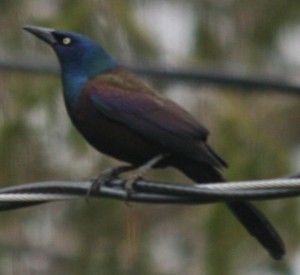Common Grackle
General:
The Common Grackle is very “common” blackbird. They often come to bird feeders in noisy flocks with other blackbirds, cowbirds, and starlings that seem to take over all other visitors. In some areas, it is now considered a pest by farmers because of their large numbers and fondness for grain.
Along with some other species of grackles, the common grackle is known to practice “anting,” rubbing insects on its feathers to apply liquids such as formic acid secreted by the insects.
These birds are aggressive and will raid picnic baskets and food at parks and beaches. I enjoy watching unsuspecting people’s food grabbed by Grackles.
They are relentless in fighting off aggressive crows and predators. A small flock of Grackles made nests in my neighbor’s two huge pine trees. One late afternoon I heard noise and saw what appeared to be 10 -12 Grackles frantic and vocal. as I approached a crow came out from the tree and took flight. What I thought were 10 grackles turned to almost 20. They took chase and for roughly 5 minutes an aerial battle took place. The crow eventually came back, I believe to rob the Grackle nests, and the Grackles fought with it within the tree. What was interesting was that the Grackle calls seemed to alert all the Grackles in the area. Within about 10 minutes over 50 grackles came and hounded the crow and eventually chased it from the nests.
During spring mating season, Female grackles typically build nests in a coniferous tree between, in d eciduous vegetation, cattails and other sites. It is my experience that grackles nest in large flocks. Each spring we have roughly twenty active grackle nests with these noisy birds. I have had Grackles nest about 10’ up in my neighbors hemlock hedges. The female lays 1–7 eggs that pale blue eggs, with black scrawls. Incubation period is 11-15 days. The chicks are born blind and helpless. They fledge in approximately 21 days.
eciduous vegetation, cattails and other sites. It is my experience that grackles nest in large flocks. Each spring we have roughly twenty active grackle nests with these noisy birds. I have had Grackles nest about 10’ up in my neighbors hemlock hedges. The female lays 1–7 eggs that pale blue eggs, with black scrawls. Incubation period is 11-15 days. The chicks are born blind and helpless. They fledge in approximately 21 days.
Identification:
Common Grackles are large, about the size of a Mourning Dove. They are 11”–13” long with a wingspan of approximately 14”-18”. Common Grackles weigh approximately 2.5–5 oz. They have long legs and long tails. Their head is flat and the bill is longer than in most blackbirds Common Grackles appear black from a distance, but up close their glossy purple heads contrast with bronzy-iridescent bodies. A bright golden/yellow eye gives grackles an intent expression. Males are slightly larger than females. Females are slightly less glossy than males.
Young birds are dark brown with a dark eye.
Habitat:
The common grackle thrives around agricultural fields, feedlots, city parks, and suburban lawns. They’re also common in open habitats including woodland, forest edges, meadows, and marshes. Unbroken tracts of forest are the only places where you are unlikely to find Common Grackles.
Territory:
The Common Grackle moves north in spring to northern Alberta, central Ontario, and Newfoundland, New England south to Gulf Coast states east of Rockies.
Migration:
This bird is a permanent resident in much of its range. Northern grackles migrate in flocks to the southeastern United States. Those Northern Common Grackles migrate to northern Kansas, southern Great Lakes region to the southern US in the winter.
Food:
The Common Grackle is omnivorous however they mostly eat seeds, corn, rice and fruits. They are frequent visitors to bird feeders. Amazingly, Grackles also eat: beetles, grasshoppers, worms, all other types of editable bugs and invertebrates, crustaceans, mollusks, fish, frogs, salamanders, mice, and other birds.